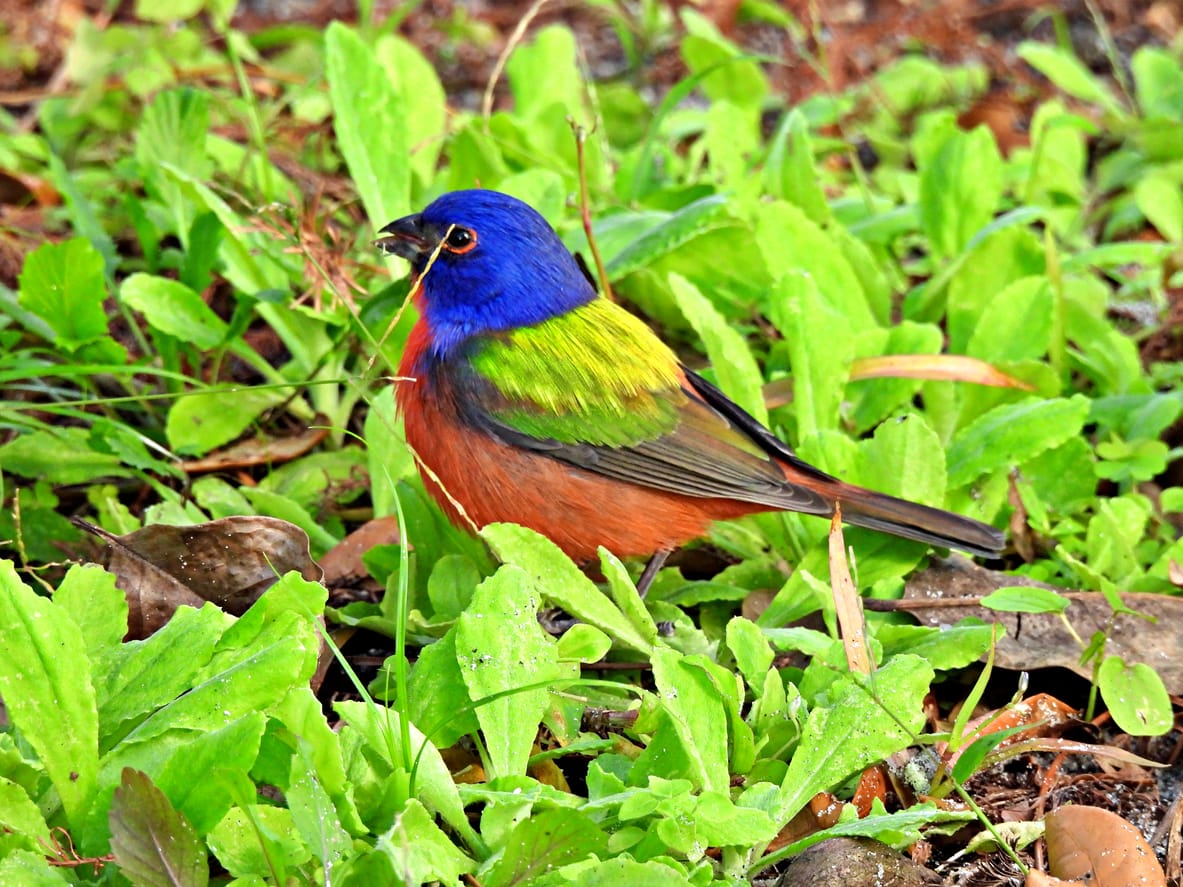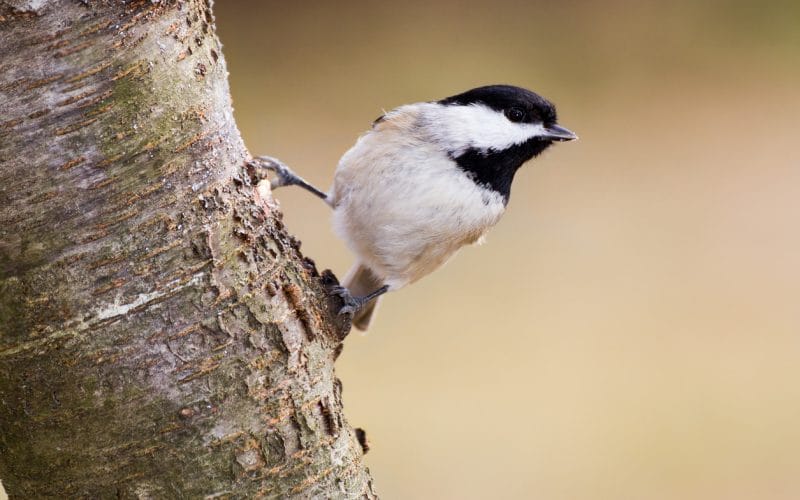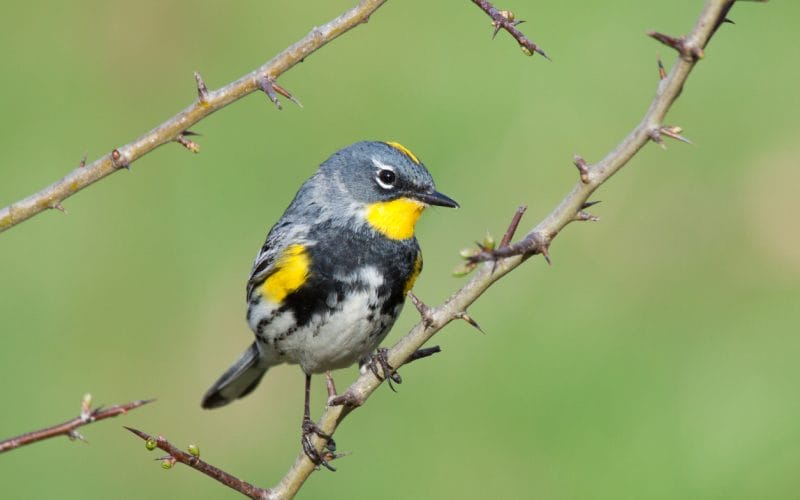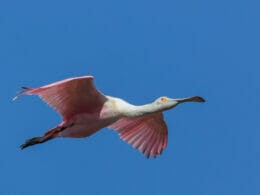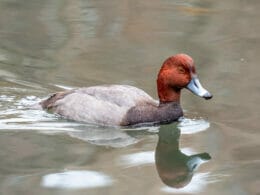While mostly known for its cowboys, rodeo, and mouthwatering Texan barbecue, the Lone Star State is actually home to a wide variety of bird species. In fact, it’s perhaps the most bird-diverse state in the nation with a staggering 655 confirmed species.
If you’re an avid birdwatcher in Texas, read on. This post lists some of the most remarkable backyard birds of Texas, along with tips on how to lure them in.
1. Northern Cardinal

- Scientific Name: Cardinalis cardinalis
- Length: 8.3–9.1 in.
- Wingspan: 8.9–12.2 in.
- Weight: 1.5–1.7 oz.
First up on our list are the ever-famous Northern Cardinals.
If you’ve ever passed through the state, you’ve likely already seen these beauties. Northern Cardinals, with their red code-shaped bills and equally red bodies, are year-round residents across the eastern half of Texas. They’re the most common backyard birds in the lone state, appearing at a frequency of 45% to 49%.
To attract these majestic creatures to your backyard, fill your feeder with seeds, berries, fruits, and corn. Although they’re not picky, they’re known to prefer white millet, sunflower seeds, safflower seeds, and shelled and cracked corn. Of those, they love black oil sunflower seeds the best.
2. Northern Mockingbird

- Scientific Name: Mimus polyglottos
- Length: 8.3–10.2 in.
- Wingspan: 12.2–13.8 in.
- Weight: 1.6–2 oz.
Northern Mockingbirds are known for their intelligence and vocal talents.
While not as eye-catching as some of the rest of the birds on this list, their larger-than-life personalities didn’t go unnoticed by Texan residents. In fact, Texas has designated Northern Mockingbirds as the official state bird in 1927!
If you have a feeder in your backyard, your chances of spotting Northern Mockingbirds are quite significant. They’re almost as common as Northern Cardinals, meaning they appear with a 45% frequency in backyards.
Northern Mockingbirds eat anything from seeds to insects. To attract these wonderful birds in your backyard, fill your feeder with various insects, berries, and fruit like raisins, apple slices, and grapes. They’ll also feed on suet blocks.
Top Tip: Don’t forget to add a birdbath, too—Northern Mockingbirds love splashing in the water!
3. Blue Jay

- Scientific Name: Cyanocitta cristata
- Length: 8.6–11.8 in.
- Wingspan: 13.3–16.9 in.
- Weight: 2.5–3.5 oz.
Blue Jays appear all throughout the eastern half of Texas.
As the name implies, these vivacious birds are blue in color. They’re especially active during late summer and early fall, with their loud Jay! Jay! calls echoing across forest edges and parks.
Although fairly common, Blue Jays are extremely cautious creatures. They avoid open spaces and would instead furtively slip through scrubs and trees in search of food. To lure them out, fill your feeders with their favorite foods like shelled peanuts, acorns, and mealworms.
4. Summer Tanager
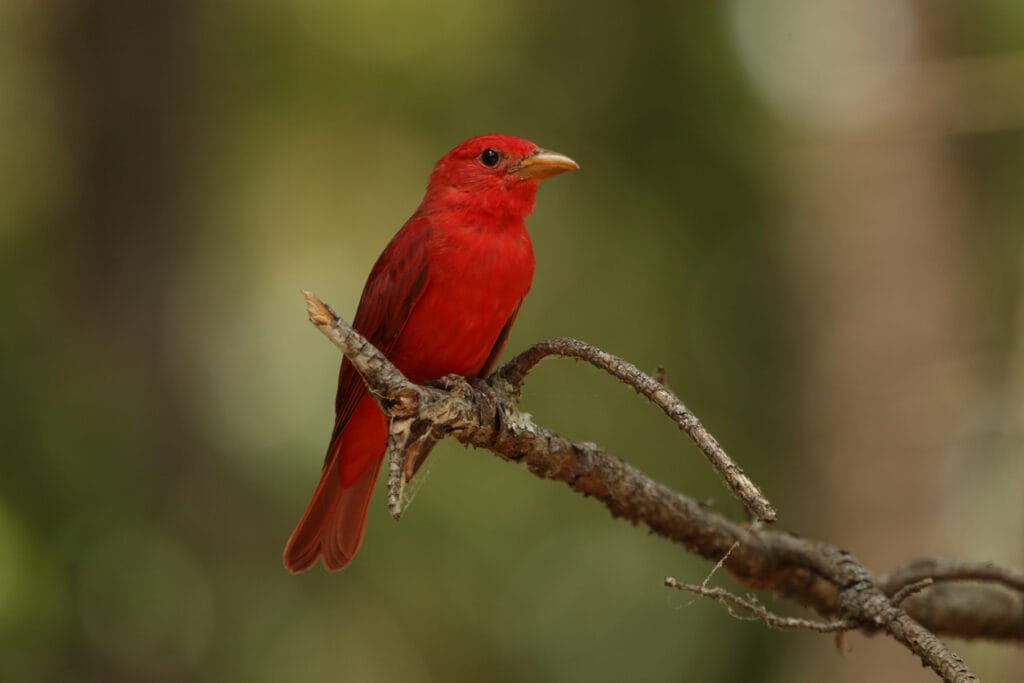
- Scientific Name: Piranga rubra
- Length: 6.1–6.9 in.
- Wingspan: 11–11.9 in.
- Weight: 0.8–1.1 oz.
Summer Tanagers, also known as Summer Redbirds, are neotropical migrants, meaning they only appear in Texas from late March to mid-May.
These elegant creatures mostly eat bees and wasps, but they certainly won’t say no to fruit, berries, and seeds. So, if you want to attract local and migrating Summer Tanagers, leave out some grapes, blackberries, pokeberries, mulberries, and bananas in your yard. They’ll gobble them right up!
Author Note: Interestingly, male Summer Tanagers are entirely bright red while females are entirely yellow.
If you’re lucky, you’ll hopefully snap a picture of a female and a male side-by-side while they’re picking at your treats. It’ll surely make a great photo!
5. Painted Bunting

- Scientific Name: Passerina ciris
- Length: 4.7–5.1 in.
- Wingspan: 8.3–9.1 in.
- Weight: 0.5–0.7 oz.
Painted Buntings are arguably the most colorful backyard songbirds found in Texas. In fact, they’re so colorful they look like they came straight out of a children’s coloring book. The French call these beauties Nonpareils, meaning “without equal” or “unrivaled.” And indeed, no one can rival this bird in terms of color…except perhaps the Red-necked Tanager.
WIth a plumage of red, blue, yellow, and green, Painted Buntings are summer-long residents of the long state. They’re mostly seen in overgrown grassy fields, old farms, and brushy road edges. Because of their ultra colorful plumage, they tend to hide in dense thickets to stay clear of predators.
If you’re lucky, they might visit your feeder for seeds during mid to late summer. To increase your chances of spotting them, fill your feeder with seeds like white millet and nyjer thistle.
6. Carolina Wren

- Scientific Name: Thryothorus ludovicianus
- Length: 4.7–5.5 in.
- Wingspan: 11.4 in.
- Weight: 0.5–0.8 oz.
Carolina Wrens are year-round residents of Texas and much of the eastern part of the United States.
These exuberant birds are quite small, standing just a few inches bigger than a House Finch. They have round bodies and short necks, with rusty brown underparts and warm-brown above.
Though not quite as colorful as some of the other birds on this list, Carolina Wrens are much more vibrant than their Wren brothers and sisters.
For such a small bird, Carolina Wrens have powerful vocals. These little things are almost comically loud for their size. They’re often seen in brushy suburban yards and shrubby thickets, so your chances of seeing these birds are quite high.
Carolina Wrens mostly feed on insects, so you can attract these beauties to your feeder with mealworms and suet.
7. Carolina Chickadee

- Scientific Name: Poecile carolinensis
- Length: 4–4.7 in.
- Wingspan: 5.9–8 in.
- Weight: 0.3–0.4 oz.
Carolina Chickadees are common backyard birds in Texas. These black-and-white beauties share a striking resemblance to Black-capped Chickadees, which is why they’re often mistaken for each other. The biggest difference between the two is that Black-capped Chickadees are larger than Carolina Chickadees.
Although they don’t often visit bird feeders, Carolina Chickadees may visit a feeder filled with sunflower seeds. They’ll also accept nectar feeders, as well.
Author Note: Since Carolina Chickadees can’t chew their food like sparrows, they’d usually take a single sunflower seed from your feeder and pound it open in a nearby branch.
8. Downy Woodpecker
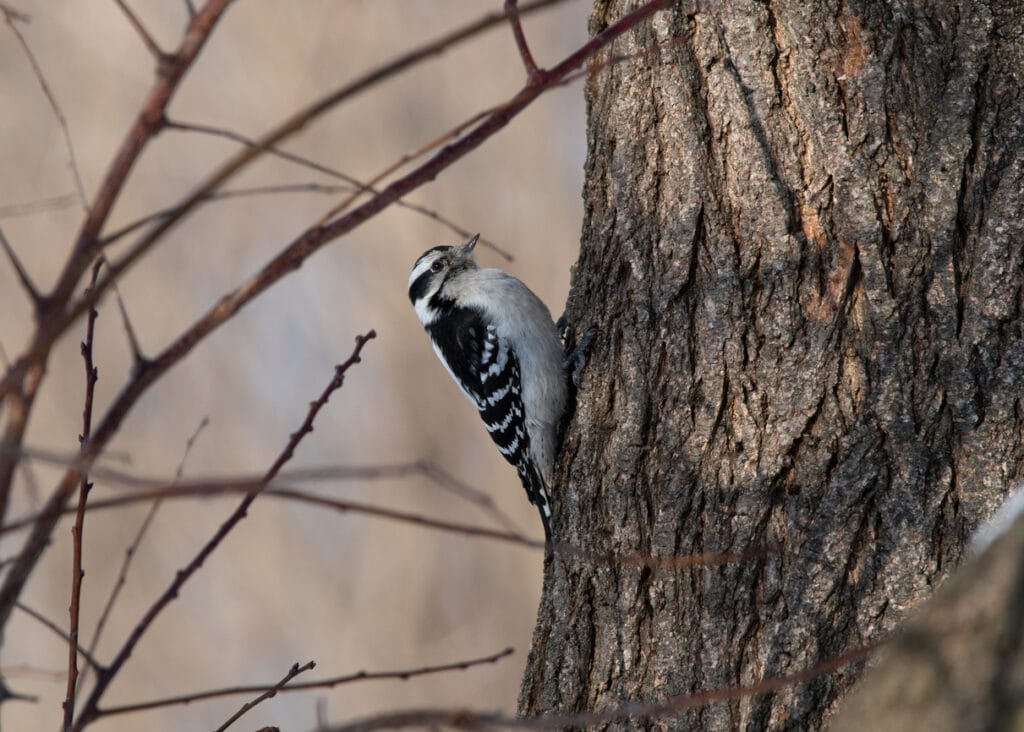
- Scientific Name: Picoides pubescens
- Length: 14–17 in.
- Wingspan: 25–31 in.
- Weight: 0.7–1 oz.
Downy Woodpeckers are the smallest woodpecker species in Texas and across North America. They’re like a mini version of the Hairy Woodpecker.
These woodpeckers make a lot of noise during spring and summer. Alongside the near-constant drumming that seems to follow them around, they make shrill, whine-like calls that can be heard for miles.
Downy Woodpeckers are a familiar sight in backyards. They eat almost anything, from insects to fruits to seeds. However, they favor suet and black oil sunflower seeds. They’d also occasionally drink from hummingbirds feeders.
9. American Goldfinch

- Scientific Name: Spinus tristis
- Length: 4.3–5.5 in.
- Wingspan: 7.5–8.7 in.
- Weight: 0.39–0.71 oz.
Covered in bright yellow plumage, American Goldfinches are hard to miss. They can be spotted throughout much of Texas, primarily in areas with an abundance of thistle and milkweed plants.
Unlike most birds, American Goldfinches are vegetarians. They only ever swallow insects inadvertently. They mostly feed on seeds, maple sap, buds, and, if there’s no other food source around, the bark of young twigs.
Author Note: To attract American Goldfinches to your yard, fill your feeder with the seeds of sunflowers, dandelions, thistles, goldenrods, asters, and burdocks. They also favor seeds from alder trees, elm trees, and conifer trees.
10. Blue Mockingbird

- Scientific Name: Melanotis caerulescens
- Length: 9.5–10.5 in.
- Wingspan: 13–14 in.
- Weight: 1.77–2.11 oz.
Blue Mockingbirds are secretive creatures, so seeing one on a bird feeder is quite the experience.
Although widespread in Central and South America, Blue Mockingbirds are regular residents of southern Texas, particularly in Rio Grande City. They mostly live in forests, dense scrubby woodlands, and riparian thickets with a maximum elevation of 10,000 feet.
Blue Mockingbirds visit bird feeders during the winter when food is scarce. They love insects, fruits, and berries, so any regular feed will do. They especially favor mealworms, sunflower seeds, peanut hearts, apple peels, and suet.
11. Rivoli’s Hummingbird
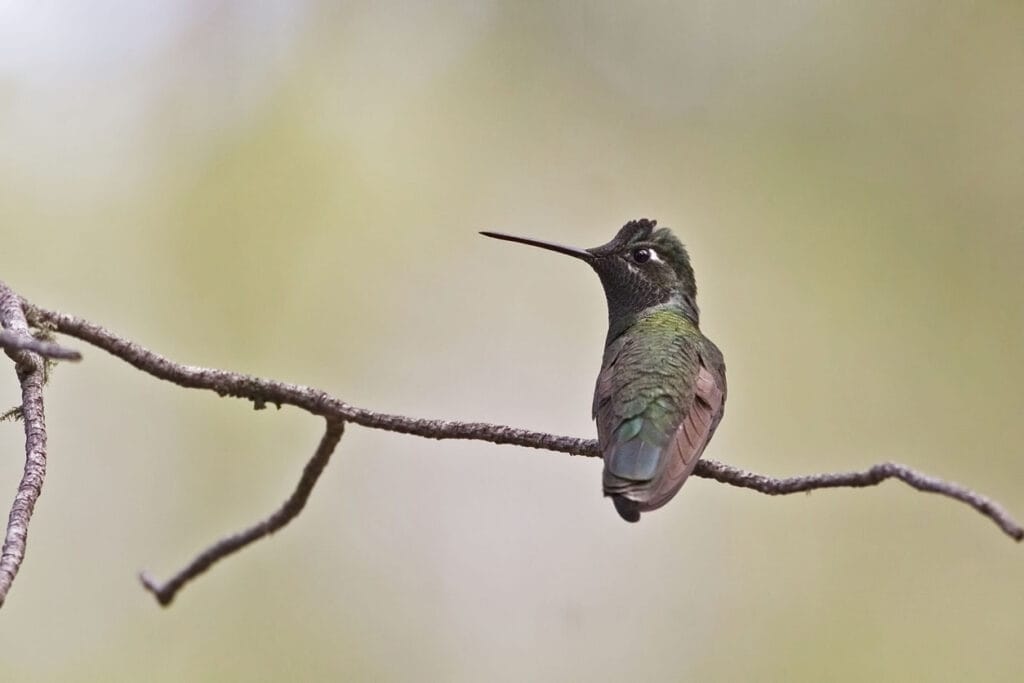
- Scientific Name: Eugenes fulgens
- Length: 4.3–5.5 in.
- Wingspan: 7.1 in.
- Weight: 0.2–0.3 oz.
Named after the Duke of Rivoli, Rivoli’s Hummingbirds, formerly called Magnificent Hummingbirds, are the second-largest hummingbird species in Texas after the Blue-throated Mountain-gem. They can be spotted in Texas’s shady canyons and pine-oak forests, where flowers grow in abundance.
Rivoli’s Hummingbirds are quite docile despite their size. Unlike Blue-throated Mountain-gems, they don’t bully other hummingbirds from flowers and feeders. Instead, they’d patiently wait until the other party leaves or search for another location to feed.
Like most hummingbirds, Rivoli’s Hummingbirds mostly feed on nectar and insects. So, make sure to incorporate several feeders throughout your yard to lure these gorgeous birds.
12. Lazuli Bunting
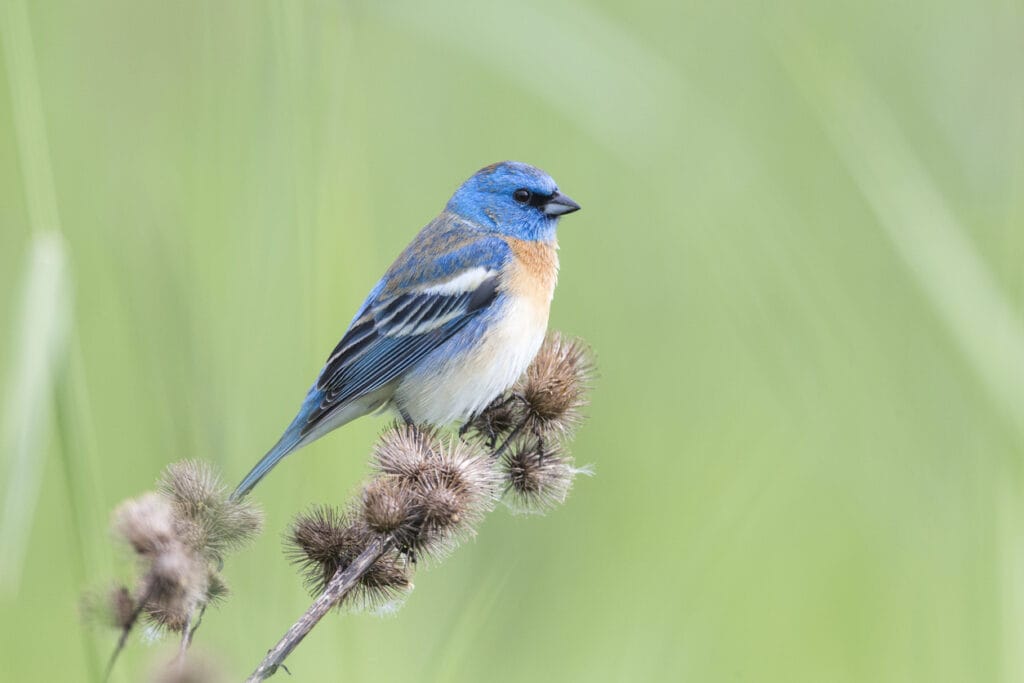
- Scientific Name: Passerina amoena
- Length: 5.1–5.9 in.
- Wingspan: 8.7 in.
- Weight: 0.5–0.6 oz.
Lazuli Buntings, named after the gemstone lapis lazuli, are year-round residents across northern, western, and central Texas.
While not as colorful as Painted Buntings, they’re still a sight to behold with their brilliant blue and white bellies and rust-colored breasts.
Lazuli Buntings are fairly secretive, but they do frequent backyard feeders filled with their favorite grains, seeds, and berries. They especially like sunflower seeds, chickweed, serviceberries, and chokecherry.
13. American Robin

- Scientific Name: Turdus migratorius
- Length: 8–11 in.
- Wingspan: 12–16 in.
- Weight: 2.7–3 oz.
American Robins are divided into two categories: Eastern American Robins and Southern American Robins. Eastern American Robins appear in Texas during winter migration, while Southern American Robins appear throughout most of the year.
American Robins—both Eastern and Southern—are immensely social creatures. They’re naturally attracted to high-density areas like towns, cities, farmlands, and lawns. So, if you have a lawn and live in a busy area, these birds will surely pay you a visit.
When it comes to food, American Robins eat almost anything. They like insects, fruits, berries, and seeds, so they’ll happily eat anything you can offer.
14. Bullock’s Orioles

- Scientific Name: Icterus bullockii
- Length: 6.7–7.5 in.
- Wingspan: 12.1–12.4 in.
- Weight: 1.0–1.5 oz.
Bullock’s Orioles are common breeding birds in southern and western Texas. With striking orange, white, and black plumage, they’re easy to spot. They’re often seen dangling upside down in forested stream sites, irrigated farms, orchards, and suburban areas.
Top Tip: Bullock’s Orioles rarely eat from seed feeders, but they do love picking at suet and sunflower seeds. They also tend to stop by in people’s backyards for sugary foods and fruits as they complete their spring migration.
Therefore, if you want to attract Bullock’s Orioles to your backyard, leave a half-and-half mixture of jelly and water. You can also leave a plate of fruits and berries for them to eat.
15. Pine Grosbeak
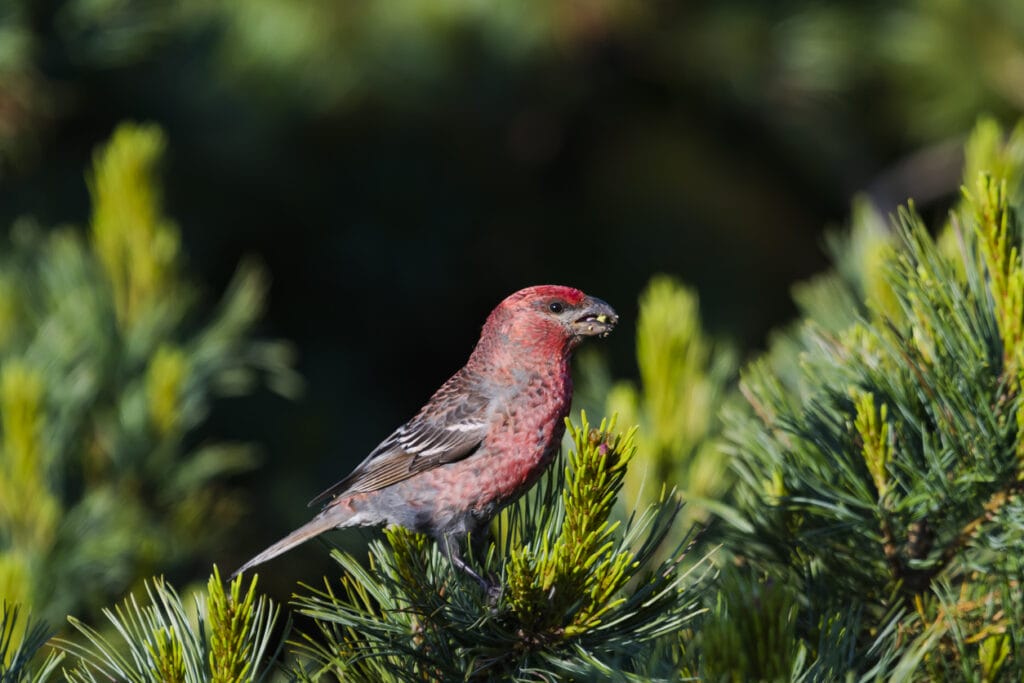
- Scientific Name: Pinicola enucleator
- Length: 9–10 in.
- Wingspan: 12–13 in.
- Weight: 1.8–2.8 oz.
Pine Grosbeaks are absurdly tame creatures that sit motionless when birdwatchers pass by. For this reason, they’re frequently overlooked even though they’re among the largest finches found in the state.
These pink-red beauties inhabit open forests of spruce, pine, and fir. When winter comes, they fly close to areas with plenty of ash and maple.
Pine Grosbeaks are mostly vegetarians, and will only eat insects if the food source is scarce. Their diet mainly consists of seeds, fruits, and buds obtained from birch, juniper, pine, and ragweed.
Since these birds mostly forage on the ground, sprinkling seeds on your lawn increases your chances of them visiting.
Conclusion
Texas’s diverse geography makes it the perfect haven for a wide array of birds. From fierce cardinals to aerobatic hummingbirds, the Lone Star State is a real treat for birdwatchers.
To increase your chances of attracting birds to your backyard, make sure to fill your feeder with a variety of seeds, fruits, and nuts. Fan favorites include sunflower seeds, suet, peanuts, and berries.
Also, make sure to add a birdbath to your yard for birds to dip in and drink once in a while.
Good luck!
FAQ
The most common bird in Texas is the American Robin.
The rarest bird in Texas is the Attwater’s Prairie Chicken.
Texas is home to a diverse array of bird species, including shorebirds, waterfowl, songbirds, raptors, and many others. Some common bird species found in Texas include the White-tailed Hawk, Greater Roadrunner, and Western Kingbird.
The official bird of Texas is the Mockingbird.




